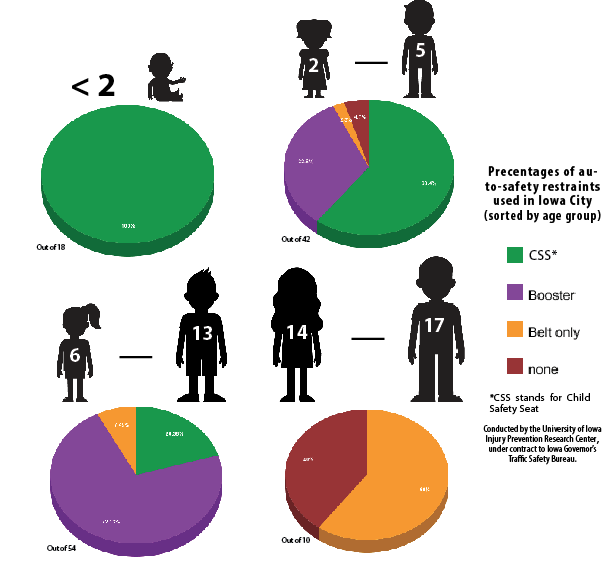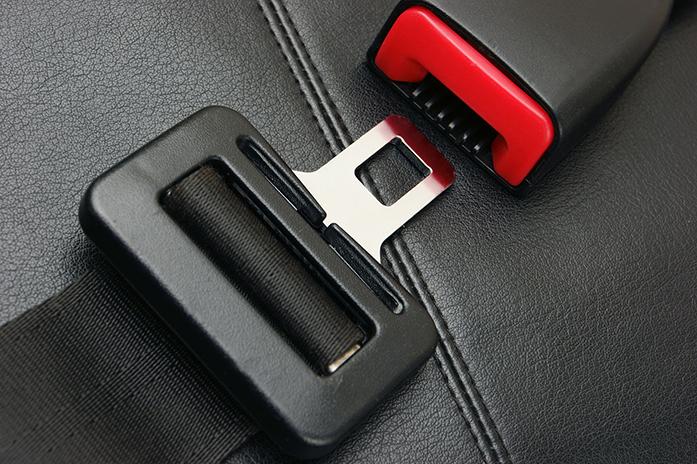By Kasra Zarei
Child injuries and fatalities resulting from motor-vehicle crashes are a major public-health problem in the United States, according to the Centers for Disease Control & Prevention.
Forms of child restraint, including seat belts, car seats, and booster seats, can save lives in the event of a crash, creating a priority to enforce their use at both state and national levels.
Since 1985, Iowa has conducted an annual child-safety-restraint study which began with a state code change that required all children under the age of 3 to be protected by safety restraints when in a vehicle.
“When the annual study started, the restraint use in Iowa was less than 50 percent for all ages,” said Cara Hamann, an associate in the UI Epidemiology Department.
There has been a considerable amount of improvement since the study started, with the 2016 results of the survey showing high compliance with strengthened state laws. The results showed compliance with 99 percent of children age 1 or younger, 93 percent of 2- to 5-year-olds, 93 percent of 6- to 13-year-olds, and 84 percent of 14- to 17-year-olds.
Observers spoke with more than 3,000 drivers with children in their cars at various convenience stores and fast-food restaurants in 36 Iowa cities between May and Au gust.
gust.
“We have conducted this study in partnership with the Governor’s Highway Traffic Safety Bureau for decades, and it’s encouraging to see that we have steadily increased child car-seat, booster-seat, and seat-belt use,” said Corinne Peek-Asa, UI professor of occupational and environmental health and director of the UI Injury Prevention Research Center.
Studies that represent non-biased data can lead to meaningful conclusions and potential policy interventions.
“The design of the study targets different size communities and observation sample sizes within the communities that resemble the state population in terms of its rural and urban composition,” Hamann said. “We believe the bias in the study is minimal — the survey is primarily conducted via observation by trained observers.”
Besides overall child-restraint-compliance rates, the study enables Hamann and her team of researchers to examine restraint use as it varies by the age of the child and rural and urban locations.
“In doing so, we can determine subgroups that may need further intervention and education to see the increases we want,” Hamann said.
The survey has revealed interesting findings, such as urban areas have higher compliance rates than rural areas in Iowa, and booster-seat use has increased following the strengthening of state laws in 2004 and 2009.
This information provides the data needed to illustrate areas in need of improvement, which is particularly useful for policymakers and for law-enforcement officials.
“The recent results of the survey reinforce our belief that parents in Iowa get it — they have been very diligent in securing their younger children while traveling,” said Mark Nagel, an occupant protection coordinator at the Iowa Department of Public Safety.
One of the conclusions of the survey is that there is more work to do in securing older children in booster seats and safety belts when they graduate out of car seats.
“We have room to grow, especially to increase occupant protection for older children and teens,” Peek-Asa said. “So many simple safety measures such as seat belts and car seats can save lives, and research in injury prevention includes identifying which safety strategies work the best, as well identifying the best ways to get these strategies into the hands of the public.”
There is always room for improvement, such as understanding the reasons some children do not have proper restraint in automobiles.
The study will continue to be conducted each year. The Governor’s Traffic Safety Bureau, part of the Iowa Department of Public Safety, funds the annual study and will continue to support this effort to provide information to researchers, families, and policymakers statewide.
“We will continue to fund the survey to monitor the efforts of caregivers in Iowa,” Nagel said. “Child-passenger safety is an ongoing commitment by our statewide program.”



